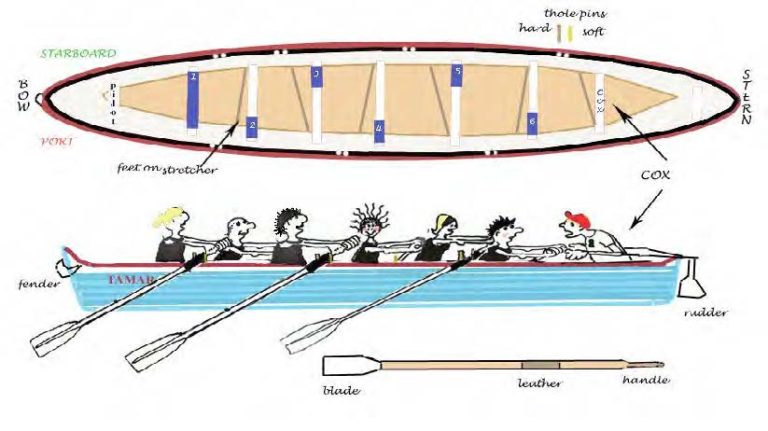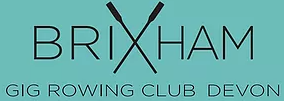Provided by Paul Goddard
The traditional Cornish Pilot Gig is a wooden six-oared rowing boat, clinker built, (wooden panels overlap down the side of the vessel), of Cornish narrow-leaf elm, 32 feet (9.8 m) long with a beam of 4 feet 10 inches (1.47 m). It is recognised as one of the first shore-based lifeboats that went to vessels in distress, with recorded rescues going back as far as the late 17th century. The original purpose of the Cornish Pilot Gig was as a general work boat, and the craft was used as a Pilot Boat, taking Pilots out to incoming vessels off the Atlantic Coast. At the time Pilots would compete between each other for work; the fastest Gig crew who got their Pilot on board a vessel first would get the job, and hence the payment.
Today, Pilot Gigs are used primarily for sport, with around 100 clubs across the globe. The main concentration is within Cornwall and the Isles of Scilly; however, clubs exist in Sussex, Somerset, Devon, Dorset, Wales & London. There are also clubs based overseas.
The ‘blunt’ end of the boat is called the ‘stern’ and attached to it is the rudder. The ‘pointy end’ is called the ‘bow’. If one stands at the stern, the left-hand side of the boat is called Port, & the right side is called Starboard. The Coxswain (Cox) sits in the stern end and uses ropes to control the rudder to steer the boat. The Cox also gives instructions to the crew, in relation to speed & power. Individual rowers sit on the 6 seats directly in front of the Cox, facing the Cox. The first rower in front of the Cox, sits on the left of the Cox and is called the ‘Stroke’. The Stroke rower takes guidance from the Cox and sets the pace and length of the oars travel through the water, (the stroke), to achieve the Cox’s speed & power requirements. The next rower down the boat sits in seat 5, on the right of the Cox, and sets the pace & power for the rowers on that side of the boat. (Rowers 6 & 5 are known as the stroke pair).

As you progress down the boat, rowers sit on alternate sides. The middle pair of rowers, seats 4 & 3, are usually the strongest rowers, and are the ‘engine room’, of the boat. That is not to say that those rowers sitting in seats 2 & 1, don’t need to be strong as well, as to achieve optimum performance the crew needs to be evenly balanced and operate as a well-oiled machine. The rowers with oars out to the right of the Cox, are called Stroke Side, & those with oars out to the left of the Cox, are called Bow side. The Cox frequently issues instructions specifically for the Stroke side rowers & also for the Bow side rowers.

When sitting in the boat, the rower will need to get a comfortable rowing position by sitting on the front edge of the seat cushion and adjusting the foot stretcher found in the bottom of the boat. The ideal position is where you can fully straighten your legs when pushing against the stretcher, whilst sliding your bum up the seat cushion, and leaning back towards the stern, allowing you to maximise the length of the oar stroke through the water, and the power of each stroke. Straps are sometimes used to help keep your feet attached to the stretcher whilst rowing. It’s better though, to row without relying on feet straps.
When seated comfortably, the oar shaft needs to sit on a small piece of leather held between two wooden pins that are set into holes in the boats’ hull, called Thole Pins. The Thole Pins are different colours, with a darker one being harder wood, & a lighter one of soft wood. The darker pin sits in the hole nearest the bow end of the boat. The lighter Pin is designed to break if the oar gets caught in the water, (called ‘catching a crab’), so as not to injure the rower or damage the boat. Spare pins are carried in the boat. The small piece of leather can be made more slippery, to aid the travel of the oar across it, by an application of Vaseline, which is also carried in the boat.
Each seating position has a specific oar, & the oars are numbered 1 to 6. You need to row with the oar that matches up with your seat position. If you are in seat 5, you use oar 5 and so on. They are numbered because the oars slightly differ in length, depending on seat position. This is to take into account the tapering of the boat. When rowing, the leather on the oar shaft is to be placed between the two Thole pins and should sit evenly, half in & half out of the boat. The spoon of the oar’s blade should face towards the Cox.
When holding the oar, one hand should be held palm down, and placed on top of the oar shaft near where the oar shaft starts to widen. The other hand should be placed underneath the oar shaft, palm up, near the end of the oar shaft handle.
You will need to get your head round a few strange words and phrases when you step into a Gig and pick up a few more as you progress. These are the ones you will hear most frequently:
General
Cox: The boss (coxswain): he or she who will be obeyed at all times – and by custom and courtesy don’t forget to thank the cox at the end of the session.
Fender: The cushion like thing that is hung off the boat to protect the Gig from damage.
Catch: When the blade of your oar catches the water at the start of the stroke.
Feathering: Turning the oars on the return stroke to reduce wind drag.
Catch a Crab: When the blade digs too deep into the water, this can push you off your seat or break a pin.
Stroke: The rower in 6 who sets the pace for the rest of the Gig.
Engine Room: The power positions in the Gig at 3 & 4.
Bow: The pointy bit at the front of the boat.
Bow Side: The “Bow Side” is our term for the Port Side of the Gig.
Bung: As in “has anyone put the bung in?” The plug that stops water getting in the boat.
Gunwale: The strong top rail of the Gig which is pronounced “Gunnel”.
Pilot Seat: The seat at the very front of the Gig also called the “Seagull Seat”.
Pins: “Thole Pins” hold the oars on the Gunwale. You pull against a hardwood pin and a softwood pin keeps the oar in place on the return stroke.
Rudder: Steers the Gig.
Stern: The opposite of the pointy bit.
Stretchers: What your feet push against.
Thwart: The bit of the Gig you sit on.
Yoke: Attached to the Rudder, gives the Cox the leverage needed to turn the Rudder by pulling on the “Yoke Lines”.
Leathers: These protect your oar and prevent chaffing in the pins. Where you row on the leathers alters your power through the water.
Vaseline: Used to reduce friction on the leathers.
Cox Commands
A command from a Cox must be obeyed without question. To stay on their good side and keep out of trouble remember these calls:
And Row: Request made by the Cox to start crew rowing.
Arms only: Row with minimum power, sitting up and using arms only (!) usually when manoeuvring the Gig.
Back Up: Row backwards – to reverse the Gig or turn it in a confined space.
Come Forward: Crew move forward into the start position.
Tap up: Call from the Cox to take a quick short stoke.
Easy Up: Stop rowing.
Hold Water: Hold your blade in the water to stop or slow the Gig.
Listen up: stop chattering, fiddling about, etc and pay attention to what the Cox is about to tell you.
Ship Oars: Stow your oars.
Pull us round: As in “Bow side pull us round” -command for only one side of Gig to row in order to turn boat.
Ready to Row: Follows “come forward” turn your blade and get ready to row – blade near the water but not in the water.
Row Hard: Instruction to row at full power.
Row Long/Lengthen Out: Instruction to keep the full length of stroke to help the Gig run.
Square your blade: At the catch, make sure your blade goes into the water at right angles to the water. Tipped back – the blade will dive deeper and you’ll probably ‘catch a crab’. Tipped forward and the blade won’t bite the water properly – your contribution to the power of that stroke will be much less (makes life harder for your crew mates) and the oar shaft may rise up out of the pins.
Stroke side: Instruction to rowers 6, 4 & 2 on what to do as in “stroke side take a stroke”.
Bow side: Instruction to rowers 5, 3 & 1 or on what to do as in “bow side take a stroke”.
Take a Stroke: is to complete the rowing action once.
Rowing is a strenuous activity, and all rowers need to be fit and healthy. Any health issues should be advised to the Cox prior to rowing.
Rowing is a water sport and you will get wet, so appropriate clothing and footwear should be worn. Best to wear layers, as you will get warm when rowing, but cool down quickly when the session is over. Footwear should be grippy, and comfortable when wet.
Care should be taken when getting in and out of the boat, particularly at low tide when the slipway may be slippery. If the black rubber mats have been laid out, they should be used to prevent slipping.
Gig boats are inherently safe and are more than capable of handling rough sea conditions. Generally, rowers over 16 years of age do not wear a life jacket. All rowers should though, be competent swimmers. In the rare event of a capsize, rowers should attempt to hang on to the boat, which will float even if upturned, until rescued.
The Cox does wear a life jacket, and before leaving shore, takes a ‘photo of the crew & this is available to be viewed by a club member remaining on shore, so a record is available of who went out in each boat. The Cox also has a VHF radio so can contact shore in the event of an emergency. The boat also contains flares to aid visibility in the event of a rescue being necessary.
Gig boats & oars are very expensive, so great care needs to be taken to not damage them.
When getting in or out of the boat, do not stand on the Pilots Seat or any of the other seats. Only stand on the floor of the boat.
If the oars being used have covers on the blades, the covers must only be taken off once the oars have been placed in the boat and replaced before the oars are removed from the boat.
The oar blades must not be used to push off from the shore by digging the blade into the floor or seabed.
When shipping the oars, the oars must be laid down in the boat carefully & not dropped.
No rubbish, or personal items should be left in the boat at the end or a rowing session.
Please select the link below to download a pdf version of this introduction to gig rowing.
